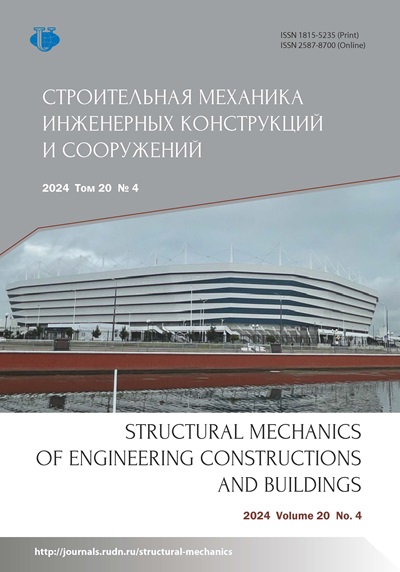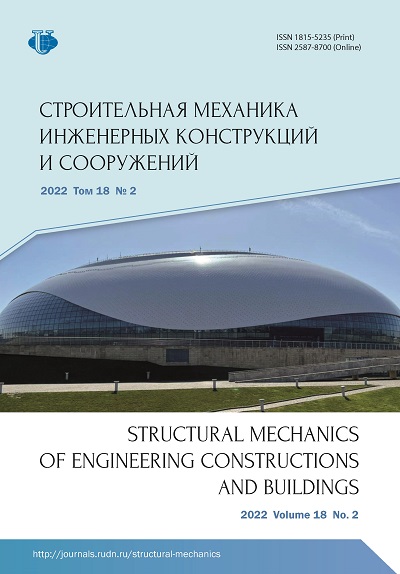Каталог землетрясений Эквадора, основанный на макросейсмической интенсивности
- Авторы: Кахамарка-Сунига Д.1,2, Кабанцев О.В.2, Марин К.1
-
Учреждения:
- Католический университет города Куэнки
- Национальный исследовательский Московский государственный строительный университет
- Выпуск: Том 18, № 2 (2022)
- Страницы: 161-171
- Раздел: Сейсмостойкость сооружений
- URL: https://journals.rudn.ru/structural-mechanics/article/view/31569
- DOI: https://doi.org/10.22363/1815-5235-2022-18-2-161-171
Цитировать
Полный текст
Аннотация
Каталоги магнитуд землетрясений и карты пиковых ускорений грунта (ПУГ, англ. PGA) для Республики Эквадор можно найти во многих исследованиях, однако работы, посвященные характеристике эпицентральной макросейсмической интенсивности, связанной с землетрясениями, встречаются редко. В связи с тем, что макросейсмическая интенсивность позволяет классифицировать степень и тяжесть ущерба, нанесенного землетрясением зданиям и сооружениям, целями данного исследования стали: 1) составление каталога землетрясений в Эквадоре на основе макросейсмической интенсивности; 2) характеристика эпицентральных макросейсмических интенсивностей, связанных с сейсмогенными источниками; 3) сравнение с Национальной картой сейсмической опасности. Впервые представлены каталог землетрясений с макросейсмической интенсивностью ≥VII и серия карт эпицентров землетрясений в соответствии с интенсивностью, глубиной очага, данными и магнитудой сейсмических событий в Эквадоре, основанных на изучении исторических и инструментальных записей с 1900 по 2021 г. Полученные данные показывают, что 95 % территории Эквадора имеют PGA > 0,1 g, что соответствует сейсмической интенсивности более VII, регионы с сейсмичностью >VIII (ag = 0,2 g) составляют 86 %, а 3,8 % территории Эквадора имеют очень высокую сейсмичность (>IX), где PGA превышает 0,5 g. Это свидетельствует о том, что нормативная Национальная карта сейсмической опасности Эквадора не учитывает опасность в основном на юго-востоке и в Центральных Андах Эквадора и требует актуализации.
Об авторах
Давид Кахамарка-Сунига
Католический университет города Куэнки; Национальный исследовательский Московский государственный строительный университет
Email: cajamarca.zuniga@gmail.com
ORCID iD: 0000-0001-8796-4635
доцент департамента строительства, Католический университет города Куэнкиt; аспирант, Национальный исследовательский Московский государственный строительный университет
Республика Эквадор, 010101, Куэнка, Ave Las Americas & Humboldt; Российская Федерация, 129337, Москва, Ярославское шоссе, д. 26Олег Васильевич Кабанцев
Национальный исследовательский Московский государственный строительный университет
Email: ovk531@gmail.com
ORCID iD: 0000-0001-9907-8470
доктор технических наук, профессор
Москва, Российская Федерация; Российская Федерация, 129337, Москва, Ярославское шоссе, д. 26Кристофер Марин
Католический университет города Куэнки
Автор, ответственный за переписку.
Email: crmaring80@gmail.com
ORCID iD: 0000-0002-6601-032X
инженер-строитель, магистр, Инженерный факультет
Республика Эквадор, 010101, Куэнка, Ave Las Americas & HumboldtСписок литературы
- About earthquakes. In: Coffman J.L. (ed.) Earthquake Information Bulletin (vol. 3). Rockville: United States National Earthquake Iinformation Center; 1971.
- Giesecke A., Gómez Capera A.A., Leschiutta I., Migliorini E., Rodriguez Valverde L. The CERESIS earthquake catalogue and database of the Andean Region: background, characteristics and examples of use. Annals of Geophysics. 2004;47(2-3):421-435. http://doi.org/10.4401/ag-3310
- Collot J.Y., Sanclemente E., Nocquet J.M., Leprêtre A., Ribodetti A., Jarrin P., Chlieh M., Graindorge D., Charvis Ph. Subducted oceanic relief locks the shallow megathrust in central Ecuador. Journal of Geophysical Research: Solid Earth. 2017;122(5):3286-3305. http://doi.org/10.1002/2016JB013849
- Mayorga E.F., Sánchez J.J. Modelling of Coulomb stress changes during the great (Mw = 8.8) 1906 Colombia-Ecuador earthquake. Journal of South American Earth Sciences. 2016;70:268-278. http://doi.org/10.1016/j.jsames.2016.05.009
- Beauval C., Marinière J., Yepes H., Audin L., Nocquet J.-M., Alvarado A., Baize S., Aguilar J., Singaucho J.-C., Jomard H. A new seismic hazard model for Ecuador. Bulletin of the Seismological Society of America. 2018;108(3A):1443-1464. http://doi.org/10.1785/0120170259
- Soto-Cordero L., Meltzer A., Bergman E., Hoskins M., Stachnik J.C., Agurto-Detzel H., Alvarado A., Beck S., Charvis Ph., Font Y., Hayes G.P., Hernandez S., Lynner C., Leon-Rios S., Nocquet J-M., Regnier M., Rietbrock A., Rolandone F., Ruiz M. Structural control on megathrust rupture and slip behavior: insights from the 2016 Mw 7.8 Pedernales Ecuador earthquake. Journal of Geophysical Research: Solid Earth. 2020;125(2). http://doi.org/10.1029/2019JB018001
- Gutscher M.A., Malavieille J., Lallemand S., Collot J.Y. Tectonic segmentation of the North Andean margin: impact of the Carnegie Ridge collision. Earth and Planetary Science Letters. 1999;168(3-4):255-270. http://doi.org/10.1016/S0012-821X(99)00060-6
- Alvarado A., Audin L., Nocquet J.M., Jaillard E., Mothes P., Jarrín P., Segovia M., Rolandone F., Cisneros D. Partitioning of oblique convergence in the Northern Andes subduction zone: migration history and the present-day boundary of the North Andean Sliver in Ecuador. Tectonics. 2016;35(5):1048-1065. http://doi.org/10.1002/2016TC004117
- Fiorini E., Tibaldi A. Quaternary tectonics in the central Interandean Valley, Ecuador: fault-propagation folds, transfer faults and the Cotopaxi Volcano. Global and Planetary Change. 2012;90-91:87-103. http://doi.org/10.1016/j.gloplacha.2011.06.002
- Tibaldi A., Rovida A., Corazzato C. Late Quaternary kinematics, slip-rate and segmentation of a major Cordillera-parallel transcurrent fault: the Cayambe-Afiladores-Sibundoy system, NW South America. Journal of Structural Geology. 2007;29(4):664-80. http://doi.org/10.1016/j.jsg.2006.11.008
- Witt C., Bourgois J., Michaud F., Ordoñez M., Jiménez N., Sosson M. Development of the Gulf of Guayaquil (Ecuador) during the Quaternary as an effect of the North Andean block tectonic escape. Tectonics. 2006;25(3):1-22. http://doi.org/10.1029/2004TC001723
- Baudino R., Hermoza W. Subduction consequences along the Andean margin: thermal and topographic signature of an ancient ridge subduction in the Marañón Basin of Perú. Geologica Acta. 2014;12(4):287-306. http://doi.org/10.1344/GeologicaActa2014.12.4.2
- Kellogg J.N., Vega V., Stailings T.C., Aiken C.L.V. Tectonic development of Panama, Costa Rica, and the Colombian Andes: constraints from Global Positioning System geodetic studies and gravity. Geologic and Tectonic Development of the Caribbean Plate Boundary in Southern Central America. 1995;295:75-90. http://doi.org/10.1130/SPE295-p75
- Dimate C., Drake L., Yepez H., Ocola L., Rendon H., Grunthal G., Giardini D. Seismic hazard assessment in the Northern Andes (PILOTO project). Annali di Geofisica. 1999;42(6):1039-1055. http://doi.org/10.4401/ag-3787
- Hoskins M.C., Meltzer A., Font Y., Agurto-Detzel H., Vaca S., Rolandone F., Nocquet J-M., Soto-Cordero L., Stachnik J.C., Beck S., Lynner C., Ruiz M., Alvarado A., Hernandez S., Charvis Ph., Regnier M., Leon-Rios S., Rietbrock A. Triggered crustal earthquake swarm across subduction segment boundary after the 2016 Pedernales, Ecuador megathrust earthquake. Earth and Planetary Science Letters. 2021;553:116620. http://doi.org/10.1016/j.epsl.2020.116620
- Pedoja K. Les terrasses marines de la marge Nord Andine (Equateur et Nord Pérou): relations avec le contexte géodynamique. Paris: Pierre and Marie Curie University (Paris 6); 2003.
- De Berc S.B., Soula J.C., Baby P., Souris M., Christophoul F., Rosero J. Geomorphic evidence of active deformation and uplift in a modern continental wedge-top - Foredeep transition: example of the eastern Ecuadorian Andes. Tectonophysics. 2005;399(1-4 SPEC. ISS.):351-80. http://doi.org/10.1016/j.tecto.2004.12.030
- Michaud F., Witt C., Royer J.Y. Influence of the subduction of the Carnegie volcanic ridge on Ecuadorian geology: reality and fiction. Backbone of the Americas: Shallow Subduction, Plateau Uplift, and Ridge and Terrane Collision. 2009;204:217-228. http://doi.org/10.1130/2009.1204(10)
- Manchuel K., Régnier M., Béthoux N., Font Y., Sallarès V., Díaz J., Yepes H. New insights on the interseismic active deformation along the North Ecuadorian-South Colombian (NESC) margin. Tectonics. 2011;30(4):1-25. http://doi.org/10.1029/2010TC002757
- Pedoja K., Dumont J.F., Lamothe M., Ortlieb L., Collot J.Y., Ghaleb B., Auclair M., Alvarez V., Labrousse B. Plio-Quaternary uplift of the Manta Peninsula and La Plata Island and the subduction of the Carnegie Ridge, central coast of Ecuador. Journal of South American Earth Sciences. 2006;22(1-2):1-21. http://doi.org/10.1016/j.jsames.2006.08.003
- Staller A., Álvarez-Gómez J.A., Luna M.P., Béjar-Pizarro M., Gaspar-Escribano J.M., Martínez-Cuevas S. Crustal motion and deformation in Ecuador from cGNSS time series. Journal of South American Earth Sciences. 2018;86:94-109. http://doi.org/10.1016/j.jsames.2018.05.014
- Dumont J.F., Santana E., Vilema W., Pedoja K., Ordóñez M., Cruz M., Jiménez N., Zambrano I. Morphological and microtectonic analysis of Quaternary deformation from Puná and Santa Clara Islands, Gulf of Guayaquil, Ecuador (South America). Tectonophysics. 2005;399(1-4 SPEC. ISS.):331-350. http://doi.org/10.1016/j.tecto.2004.12.029
- Egbue O., Kellogg J. Pleistocene to present North Andean “escape.” Tectonophysics. 2010;489(1-4):248-257. http://doi.org/10.1016/j.tecto.2010.04.021
- Yepes H., Audin L., Alvarado A., Beauval C., Aguilar J., Font Y., Cotton F. A new view for the geodynamics of Ecuador: implication in seismogenic source definition and seismic hazard assessment. Tectonics. 2016;35(5):1249-1279. http://doi.org/10.1002/2015TC003941
- Taboada A., Rivera L.A., Fuenzalida A., Cisternas A., Philip H., Bijwaard H., Olaya J., Rivera C. Geodynamics of the northern Andes: subductions and intracontinental deformation (Colombia). Tectonics. 2000;19(5):787-813.
- Nocquet J.M., Villegas-Lanza J.C., Chlieh M., Mothes P.A., Rolandone F., Jarrin P., Cisneros D., Alvarado A., Audin L., Bondoux F., Martin X., Font Y., Régnier M., Vallée M., Tran T., Beauval C., Maguiña Mendoza J.M., Martinez W., Tavera H., Yepes H. Motion of continental slivers and creeping subduction in the northern Andes. Nature Geoscience. 2014;7(4):287-291. http://doi.org/10.1038/ngeo2099
- Ego F., Sébrier M., Lavenu A., Yepes H., Egues A. Quaternary state of stress in the Northern Andes and the restraining bend model for the Ecuadorian Andes. Tectonophysics. 1996;259(1-3 SPEC. ISS.):101-116. http://doi.org/10.1016/0040-1951(95)00075-5
- Soulas J.P., Eguez A., Yepes H., Perez H. Active tectonics and seismic hazard in the Ecuadorian Andes and the extreme south of Colombia. Ecuadorian Geological Bulletin. 1991;2(1):3-11.
- Winter T., Avouac J.-P., Lavenu A. Late Quaternary kinematics of the Pallatanga strike-slip fault (Central Ecuador) from topographic measurements of displaced morphological features. Geophysical Journal International. 1993;115(3):905-920. http://doi.org/10.1111/j.1365-246X.1993.tb01500.x
- Salocchi A.C., Minarelli L., Lugli S., Amoroso S., Rollins K.M., Fontana D. Liquefaction source layer for sand blows induced by the 2016 megathrust earthquake (Mw 7.8) in Ecuador (Boca de Briceño). Journal of South American Earth Sciences. 2020;103(June):102737. http://doi.org/10.1016/j.jsames.2020.102737
- Beauval C., Yepes H., Palacios P., Segovia M., Alvarado A., Font Y., Aguilar J., Troncoso L., Sandro Vaca S. An earthquake catalog for seismic hazard assessment in Ecuador. Bulletin of the Seismological Society of America. 2013;103(2 A):773-786. http://doi.org/10.1785/0120120270
- Beauval C., Yepes H., Bakun W.H., Egred J., Alvarado A., Singaucho JC. Locations and magnitudes of historical earthquakes in the Sierra of Ecuador (1587-1996). Geophysical Journal International. 2010;181(3):1613-1633. http://doi.org/10.1111/j.1365-246X.2010.04569.x
- Swenson J.L., Beck S.L. Historical 1942 Ecuador and 1942 Peru subduction earthquakes, and earthquake cycles along Colombia-Ecuador and Peru subduction segments. Pure and Applied Geophysics. 1996;146:67-101. http://doi.org/10.1007/bf00876670
- Richter C.F. Elementary seismology (J. Gilluly, A.O. Woodford, eds.). San Francisco: W.H. Freeman and Company; 1958.
- Murphy J.R., O’Brien L.J. The correlation of peak ground acceleration amplitude with seismic intensity and other physical parameters. Bulletin of the Seismological Society of America. 1977;67(3):877-915. http://doi.org/10.1785/BSSA0670030877
- Linkimer L. Relationship between peak ground acceleration and modified Mercalli intensity in Costa Rica. Revista Geológica de América Central. 2008;38:81-94.
















